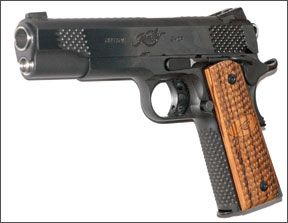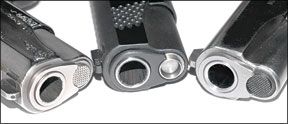We’ve had a Raptor II for a while, waiting for a suitable matchup from several makers who have thus far failed to provide us with a similar product, so we finally chose to have a good look at this pistol all on its own. To give some idea of the variety of 1911s in the Kimber line, within just the Raptor’s “cage” there are seven variants. These include the Grand, Pro, and Ultra models in both blued and stainless, or a mix of the two colors. Ours is all blue, and carries a price tag of $1434.

288
We did our testing right after having looked at a surplus CZ 9mm and a new Tokarev 9mm, and must say, compared to those, the Kimber is a thoroughly professional-grade handgun. Its price is nearly five times the price of the others, so one would expect a better gun. Let’s find out just how much better it is. We tested the Kimber with three types of ammo, 230-grain hardball by MFS, Winchester’s truncated-cone 185-grain BEB, and with Cor-Bon Pow’Rball 165-grain ball nose.
Kimber Raptor II 45 ACP, $1434
The gun was absolutely gorgeous. The deep, rich bluing was set off by grips that had, appropriately, a sort of feathery treatment instead of just plain checkering. These worked well, providing decent traction without causing the hand to stick or catch as the gun is grabbed from the holster. The front strap and the slide were given a ball-cut roughening treatment that provided great traction for the hand to grip the gun and to operate the slide or press-check it for a loaded round.
The sides of the slide and frame were absolutely flat with no waviness, and had a uniform, semi-gloss polish. The top of the slide and the edges of the frame had a matte-blued finish to cut glare. The left side of the slide had the Kimber logo surrounded by “CUSTOM SHOP” in muted, smallish letters. The right side bore the Raptor II name in the same tasteful small print. Two eight-shot magazines came with the gun along with a take-down wrench. One of the mags had a slam pad. The gun had ambidextrous safeties that did not interfere with our knuckle, so we could tolerate them, and fixed sights with tritium inserts. The top of the slide had a line of cuts in it that formed a matte surface leading to the front sight. Both sights were dovetailed into the slide top. The rear sight had an Allen screw to retain its windage position. The sights, when we tried the gun, were right on the money.
There was no noticeable play between the slide and the frame. The barrel had no excess play at both front and back, which promised good accuracy. One of the more clever safety features about the Kimber is the firing-pin lockout, which is disabled by the grip safety instead of the trigger. Pressing on the grip safety shoves a pin in the frame upward, which in turn clears the firing-pin block. This means the gun can’t be fired unless you have a decent grip on it. This setup does not cause an increase in the necessary trigger pressure or interfere with the trigger pull in any way. The Kimber had an excellent pull. The trigger broke at a very consistent and clean 4.4 pounds. It had absolutely no creep, and the overtravel was adjusted to be minimal after the break.

288
Takedown was the common 1911-45 style, though we had to use the bushing wrench because of the perforated spring cap, which was pierced to accommodate the long recoil-spring guide. Inside the gun the workmanship was just as good as on the outside, minus the final polishing. There were no jagged marks, no burrs, just clean honest machining and finishing. The fit of all the parts we looked at was excellent. That’s what you’re paying for with a gun like this. That makes the gun easier to maintain, lets it operate more smoothly, and lets it shoot better because of the snug and careful fitting. One small thing we found was the rear corner of the ejection port was not as rounded as we’d like, though it was not at all sharp.
How does this stack up compared to other guns we’ve seen in its price range? The famous and now-discontinued Valtro began its life within a couple hundred dollars of the Raptor II’s price, though they sell for a king’s ransom today if you can find one. The Raptor’s smooth feel to its slide motion and other controls were on a par with those of the Valtro, though it does not have the Valtro’s detail touches like fine checkering, nor its recessed cross-pin setup. The Raptor’s polish and bluing are nearly as good, though it’s hard to tell because the Valtro was more highly polished. And the Valtro’s edges were somewhat more rounded or eased.
Another good comparison would be a lower-cost 45 with some added custom touches, maybe a trigger job, and some final tuning done by a good gunsmith. The price for custom work could easily get the price of a plain, low-cost gun up to about what you’d pay for the Raptor II. However, the sale price in, say, 20 years for a customized handgun would most likely be less than that of a 20-year-old Raptor II, unless the gunsmith was one of the very best, like Pachmayr, Fisher, or Christiansen, and the ‘smith had signed the gun.
A similar handgun to the Raptor II is the Wilson CQB, which used to be in this price range but is now sky-high. In our experience we think the Raptor II would be an excellent alternative to the Wilson, and for a lot less money. Today’s CQB starts at $2865, about twice the price of the Kimber Raptor II. Is the CQB twice the gun? That’s up to you and your banker to decide.
Our Team Said: We took the Raptor II to the range and we were not disappointed with its performance. The gun worked perfectly, shot to its sights, and grouped very well. Of the three types of ammo tried, the gun did best with hardball. We noticed the gun tended to group better the more we shot it, as the parts got used to those next to ‘em. We could not fault the gun. We thought the pistol earned an ‘A’ grade and was worth every penny of its cost.
Written and photographed by Ray Ordorica, using evaluations from Gun Tests team testers.






























I love your blog.. very nice colors & theme. Did you create this website yourself or did you hire someone to do it for you? Plz respond as I’m looking to construct my own blog and would like to find out where u got this from. kudos